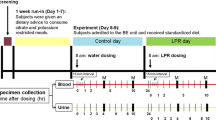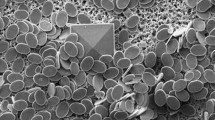Abstract
Potassium citrate has long been used as a prophylactic remedy for nephrolithiasis recurrence. Lemonade consumption is also suggested as an option. We compared the efficacy of consumption of solution containing manufactured lime powder with that of potassium citrate, on the improvement of metabolic risk factors, oxidative stress and renal tubular damage in nephrolithiasis patients. Patients with kidney stone were enrolled and randomly assigned to three treatment programs for 3 month period consisting of consumption of solution containing lime powder (Group 1, n = 13), potassium citrate (Group 2, n = 11) and lactose as placebo regimen (Group 3, n = 7). Lime powder and potassium citrate contained equal amounts of potassium (21 mEq) and citrate (63 mEq). After treatment, there was an increase in urinary pH, potassium and citrate in Group 1 and 2. Increased plasma potassium and red blood cell glutathione (R-GSH) and decreased urinary malondialdehyde were found in Group 1, but not observed in Group 2. R-GSH was decreased in Group 2. Urinary N-acetyl-β-glucosaminidase activity and fractional excretion of magnesium, as renal tubular damage indicators, were decreased only in Group 1. In Group 3, all measured parameters were unaltered except for an increased urinary chloride. In conclusion, consumption of our in-house lime powder exerted citraturic and alkalinizing actions as efficient as consumption of potassium citrate. In addition, it provided an antioxidative effect and was able to attenuate renal tubular damage. These pharmacological properties may be clinically useful to diminish the stone-forming potential in kidney stone patients and hence for preventing recurrent calculi.

Similar content being viewed by others
References
Moe OW (2006) Kidney stones: pathophysiology and medical management. Lancet 367:333–344
Khan SR (2006) Renal tubular damage/dysfunction: key to the formation of kidney stones. Urol Res 34:86–91
Huang HS, Ma MC, Chen CF, Chen J (2003) Lipid peroxidation and its correlations with urinary levels of oxalate, citric acid, and osteopontin in patients with renal calcium oxalate stones. Urology 62:1123–1128
Tungsanga K, Sriboonlue P, Futrakul P, Yachantha C, Tosukhowong P (2005) Renal tubular cell damage and oxidative stress in renal stone patients and the effect of potassium citrate treatment. Urol Res 33:65–69
Boonla C, Wunsuwan R, Tungsanga K, Tosukhowong P (2007) Urinary 8-hydroxydeoxyguanosine is elevated in patients with nephrolithiasis. Urol Res 35:185–191
Pak CY, Fuller C, Sakhaee K, Preminger GM, Britton F (1985) Long-term treatment of calcium nephrolithiasis with potassium citrate. J Urol 134:11–19
Mattle D, Hess B (2005) Preventive treatment of nephrolithiasis with alkali citrate—a critical review. Urol Res 33:73–79
Preminger GM, Harvey JA, Pak CY (1985) Comparative efficacy of “specific” potassium citrate therapy versus conservative management in nephrolithiasis of mild to moderate severity. J Urol 134:658–661
Barcelo P, Wuhl O, Servitge E, Rousaud A, Pak CY (1993) Randomized double-blind study of potassium citrate in idiopathic hypocitraturic calcium nephrolithiasis. J Urol 150:1761–1764
Gaharagozloo M, Doroudchi M, Ghaderi A (2002) Effects of Citrus aurantifolia concentrated exact on the spontaneous proliferation of MDA-MB–453 and RPMI–8866 tumor cell lines. Phytomedicine 9:475–477
Seltzer MA, Low RK, McDonald M, Shami GS, Stoller ML (1996) Dietary manipulation with lemonade to treat hypocitraturic calcium nephrolithiasis. J Urol 156:907–909
Kang DE, Sur RL, Haleblian GE, Fitzsimons NJ, Borawski KM, Preminger GM (2007) Long-term lemonade based dietary manipulation in patients with hypocitraturic nephrolithiasis. J Urol 177:1358–1362, discussion 1362; quiz 1591
Koff SG, Paquette EL, Cullen J, Gancarczyk KK, Tucciarone PR, Schenkman NS (2007) Comparison between lemonade and potassium citrate and impact on urine pH and 24-h urine parameters in patients with kidney stone formation. Urology 69:1013–1016
Leong LP, Shui G (2002) An investigation of antioxidant capacity of fruits in Singapore markets. Food Chem 76:69–75
Jayaprakasha GK, Patil BS (2007) In vitro evaluation of the antioxidant activities in fruit extracts from citron and blood orange. Food Chem 101:410–418
Preminger GM, Sakhaee K, Pak CY (1988) Alkali action on the urinary crystallization of calcium salts: contrasting responses to sodium citrate and potassium citrate. J Urol 139:240–242
Koenig K, Padalino P, Alexandrides G, Pak CY (1991) Bioavailability of potassium and magnesium, and citraturic response from potassium–magnesium citrate. J Urol 145:330–334
Pak CY (1994) Citrate and renal calculi: an update. Miner Electrolyte Metab 20:371–377
Ettinger B, Pak CY, Citron JT, Thomas C, Adams-Huet B, Vangessel A (1997) Potassium–magnesium citrate is an effective prophylaxis against recurrent calcium oxalate nephrolithiasis. J Urol 158:2069–2073
Tosukhowong P, Borvonpadungkitti S, Prasongwatana V, Tungsanga K, Jutuporn S, Dissayabutr T, Reungjui S, Sriboonlue P (2002) Urinary citrate excretion in patients with renal stone: roles of leucocyte ATP citrate lyase activity and potassium salts therapy. Clin Chim Acta 325:71–78
Zerwekh JE, Odvina CV, Wuermser LA, Pak CY (2007) Reduction of renal stone risk by potassium–magnesium citrate during 5 weeks of bed rest. J Urol 177:2179–2184
Hamm LL, Hering-Smith KS (2002) Pathophysiology of hypocitraturic nephrolithiasis. Endocrinol Metab Clin North Am 31:885–893, viii
Hofbauer J, Hobarth K, Szabo N, Marberger M (1994) Alkali citrate prophylaxis in idiopathic recurrent calcium oxalate urolithiasis—a prospective randomized study. Br J Urol 73:362–365
Wabner CL, Pak CY (1993) Effect of orange juice consumption on urinary stone risk factors. J Urol 149:1405–1408
Lenton KJ, Sane AT, Therriault H, Cantin AM, Payette H, Wagner JR (2003) Vitamin C augments lymphocyte glutathione in subjects with ascorbate deficiency. Am J Clin Nutr 77:189–195
Acknowledgments
The authors are grateful to Professor Yoshihide Ogawa and Dr. Rayhan Zubair Hossain at Department of Urology, University of Ryukyus, Japan for generous advices, and thankful to Dr. Phisit Prapunwatana for comments.
Conflict of interest statement
Supported by Grants from Division of Nephrology, Faculty of Medicine, and from the Graduate School, Chulalongkorn University.
Author information
Authors and Affiliations
Corresponding author
Rights and permissions
About this article
Cite this article
Tosukhowong, P., Yachantha, C., Sasivongsbhakdi, T. et al. Citraturic, alkalinizing and antioxidative effects of limeade-based regimen in nephrolithiasis patients. Urol Res 36, 149–155 (2008). https://doi.org/10.1007/s00240-008-0141-9
Received:
Accepted:
Published:
Issue Date:
DOI: https://doi.org/10.1007/s00240-008-0141-9




